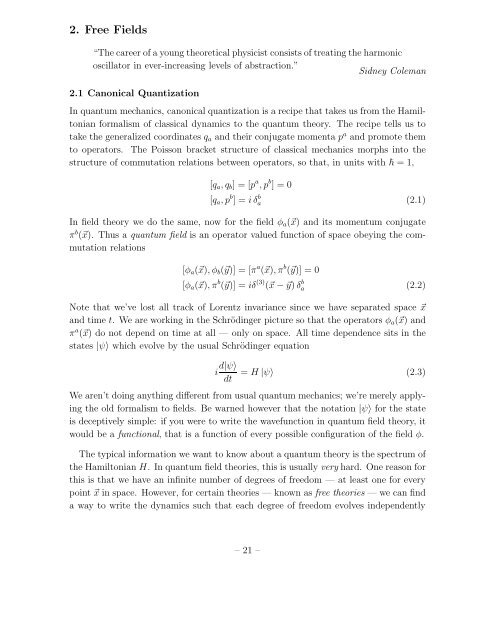Quantum Field Theory
Quantum Field Theory
Quantum Field Theory
Create successful ePaper yourself
Turn your PDF publications into a flip-book with our unique Google optimized e-Paper software.
2. Free <strong>Field</strong>s“The career of a young theoretical physicist consists of treating the harmonicoscillator in ever-increasing levels of abstraction.”Sidney Coleman2.1 Canonical QuantizationIn quantum mechanics, canonical quantization is a recipe that takes us from the Hamiltonianformalism of classical dynamics to the quantum theory. The recipe tells us totake the generalized coordinates q a and their conjugate momenta p a and promote themto operators. The Poisson bracket structure of classical mechanics morphs into thestructure of commutation relations between operators, so that, in units with = 1,[q a , q b ] = [p a , p b ] = 0[q a , p b ] = i δ b a (2.1)In field theory we do the same, now for the field φ a (⃗x) and its momentum conjugateπ b (⃗x). Thus a quantum field is an operator valued function of space obeying the commutationrelations[φ a (⃗x), φ b (⃗y)] = [π a (⃗x), π b (⃗y)] = 0[φ a (⃗x), π b (⃗y)] = iδ (3) (⃗x − ⃗y) δ b a (2.2)Note that we’ve lost all track of Lorentz invariance since we have separated space ⃗xand time t. We are working in the Schrödinger picture so that the operators φ a (⃗x) andπ a (⃗x) do not depend on time at all — only on space. All time dependence sits in thestates |ψ〉 which evolve by the usual Schrödinger equationi d|ψ〉dt= H |ψ〉 (2.3)We aren’t doing anything different from usual quantum mechanics; we’re merely applyingthe old formalism to fields. Be warned however that the notation |ψ〉 for the stateis deceptively simple: if you were to write the wavefunction in quantum field theory, itwould be a functional, that is a function of every possible configuration of the field φ.The typical information we want to know about a quantum theory is the spectrum ofthe Hamiltonian H. In quantum field theories, this is usually very hard. One reason forthis is that we have an infinite number of degrees of freedom — at least one for everypoint ⃗x in space. However, for certain theories — known as free theories — we can finda way to write the dynamics such that each degree of freedom evolves independently– 21 –
















